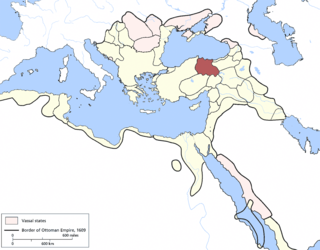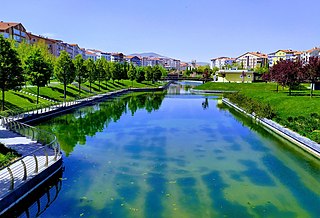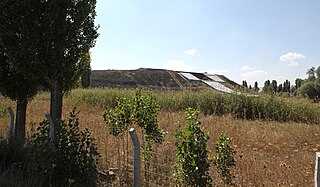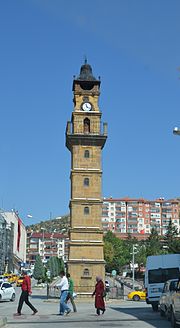
Anatolia, also known as Asia Minor, is a large peninsula located in West Asia and a region of Turkey, constituting most of its contemporary territory. Geographically, the Anatolian region is bounded by the Mediterranean Sea to the south, the Aegean Sea to the west, the Turkish Straits to the north-west, and the Black Sea to the north. The eastern and southeastern boundary is either the southeastern and eastern borders of Turkey, or an imprecise line from the Gulf of Iskenderun to the Black Sea. Topographically, the Sea of Marmara connects the Black Sea with the Aegean Sea through the Bosporus strait and the Dardanelles strait, and separates Anatolia from Thrace in the Balkan peninsula of Southeastern Europe.

Çorum is a province in the Black Sea Region of Turkey, but lying inland and having more characteristics of Central Anatolia than the Black Sea coast. Its area is 12,428 km2, and its population is 524,130 (2022). Its provincial capital is the city of Çorum, the traffic code is 19.

Çorum is a northern Anatolian city in Turkey. Çorum is located inland in the central Black Sea Region of Turkey and is approximately 244 km (152 mi) from Ankara and 608 km (378 mi) from Istanbul. It is the seat of Çorum Province and of Çorum District. Its population is 269,595 (2022). The city has an elevation of 801 m (2,628 ft) above sea level.

The Eyalet of Rûm, later named as the Eyalet of Sivas, was an eyalet of the Ottoman Empire in northern Anatolia, founded following Bayezid I's conquest of the area in the 1390s. The capital was the city of Amasya, which was then moved to Tokat and later to Sivas. Its reported area in the 19th century was 28,912 square miles (74,880 km2).

Bilecik Province is a province in midwest Turkey, neighboring Bursa to the west, Kocaeli and Sakarya to the north, Bolu to the east, Eskişehir to the southeast and Kütahya to the south. Its area is 4,179 km2, and its population is 228,673 (2022). Most of the province laid down in Marmara Region but eastern parts of Gölpazarı and Söğüt district and districts of İnhisar and Yenipazar remained in Black Sea Region, smaller southeastern parts of Bozüyük and Söğüt remained in Central Anatolia Region and smaller southwestern part of Bozüyük remained in Aegean Region.

Kırşehir, historically known as Mocissus or Mokissos and Justinianopolis (Ἰουστινιανούπολις) in ancient times, is a city in Turkey. It is the seat of Kırşehir Province and Kırşehir District. Its population is 150,700 (2022). Its elevation is 1,027 m (3,369 ft). The Mayor of Kırşehir is Selahattin Ekicioğlu.
Kerkenes is the largest pre-Hellenistic site from the Anatolian Plateau (Turkey) – 7 km (4 mi) of strong stone defenses, pierced by seven gates, that enclose 2.5 km2 (1.0 sq mi). It is located about 200 km (120 mi) east from Ankara, between the towns of Yozgat (W) and Sorgun (E).

The Vilayet of Angora or Ankara was a first-level administrative division (vilayet) of the Ottoman Empire, centered on the city of Angora (Ankara) in north-central Anatolia, which included most of ancient Galatia.

İskilip is a district of Çorum Province, Turkey, on the left bank of the River Kızılırmak, located at 56 km from the city of Çorum, 100 miles northeast of Ankara and 60 miles southeast of Kastamonu. It is the seat of İskilip District. Its population is 17,612 (2022). The mayor is Ali Sülük.

The Museum of Anatolian Civilizations is located on the south side of Ankara Castle in the Atpazarı area in Ankara, Turkey. It consists of the old Ottoman Mahmut Paşa bazaar storage building, and the Kurşunlu Han. Because of Atatürk's desire to establish a Hittite museum, the buildings were bought upon the suggestion of Hamit Zübeyir Koşay, who was then Culture Minister, to the National Education Minister, Saffet Arıkan. After the remodelling and repairs were completed (1938–1968), the building was opened to the public as the Ankara Archaeological Museum.

Bor is a town in Niğde Province in the Central Anatolia region of Turkey, 14 km (8.7 mi) to the southeast of the city of Niğde, on a high plain. It is the seat of Bor District. Its population is 41,999 (2022).

The following outline is provided as an overview of and topical guide to the Ottoman Empire:

The Eyalet of Ankara or Angora, also known as the Eyalet of Bosok or Bozok was an eyalet of the Ottoman Empire.

Kaman-Kalehöyük is a multi-period archaeological site in Kırşehir Province, Turkey, around 100 km south east of Ankara, 6 km east of the town center of Kaman. It is a tell or mound site that was occupied during the Bronze Age, Iron Age and Ottoman periods. Excavations in the mound have been carried out since 1986 under the direction of Sachihiro Omura, on behalf of the Middle Eastern Culture Center in Japan and the Japanese Anatolian Archeology Institute. The distance to Hattusa, the Hittite capital, is about 100 km.
Amasya Museum, also known as Archaeological Museum of Amasya, is a national museum in Amasya, northern Turkey, exhibiting archaeological artifacts found in and around the city as well as ethnographic items related to the region's history of cultural life. Established in 1958, the museum owns nearly twenty-four thousand items for exhibition belonging to eleven historic civilizations.

The Çapanoğlu dynasty, also Cebbarzâdeler, Çaparzâdeler and Çaparoğulları, is Turkish dynasty that originates in the 17th-century Ottoman Empire and was once one of the most prominent Ottoman families. They became one of the most powerful dynasties in the empire in the 18th century.

Süleyman Bey or Capanoğlu Süleyman Bey was an Ottoman military leader and office holder from the Çapanoğlu family, one of the most powerful Ottoman dynasties of the 18th century. Under his guidance the family reached its peak of prominence.

The Çapanoğlu Uprising or Yozgat Rebellion took place in Yozgat during the Turkish War of Independence and was led by Çapanoğlu Edip Bey and his brother Celal Bey. The uprising happened in two phases, the First Yozgat Uprising, which the government mistakenly declared suppressed, and the Second Yozgat Uprising.
Çapanoğlu Mustafa Ahmed Pasha was a prominent Ottoman officeholder and a member of the Çapanoğlu family, which he led after the death of his father Ahmed. Among his accomplishment are the construction of the baroque, domed Çapanoğlu Mosque in his native Yozgat, founded by the family.
Usakli Hoyuk is located at Büyüktaslik Village in the district of Sorgun, Yozgat Province, Turkey, to the north of Mount Kerkenes. It was an important Hittite city that flourished in the second millennium BC, and was identified as a possible location of the ancient city of Zippalanda, the centre of the cult of the Storm God.





















